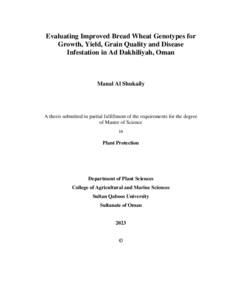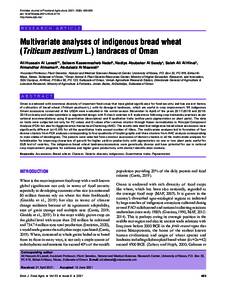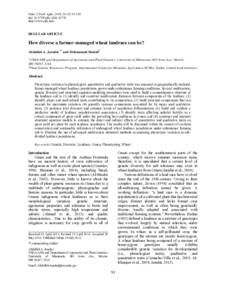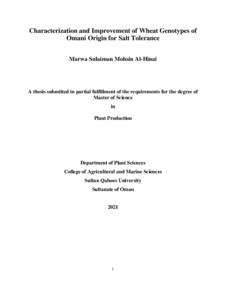Document
Evaluating improved bread wheat genotypes for growth, yield, grain quality and disease infestation in Ad Dakhiliyah, Oman.
Source
Master's thesis
Country
Oman
City
Muscat
Publisher
Sultan Qaboos University
Gregorian
2023
Language
English
Thesis Type
Master's thesis
English abstract
Bread wheat is one the leading staples and strategic crops in the Sultanate of Oman.
However, the domestic production is far less than the national requirements. Moreover,
increasing population pressure and climate change challenges further add to the
problem. The situation requires introduction and evaluation of high yielding improved
genotypes to contribute towards national food security. The study was conducted at
Jimah Research Station, Ministry of Agriculture, Fisheries and Water Resources,
Jimah, Behla, Al-Dakhiliyah, Oman during 2022-2023. Nine exotic (TW1509,
CMT9423, CMT9411, SQU28, SQU113, SQU150, HT50, CMT9420, CMT9403) and
three local (WQ110, WQ227, WQ230) improved bread wheat genotypes in a
randomized complete block design with three replications under natural open filed
conditions. The experimental soil was sandy loam with a pH of 8.1. The wheat
genotypes were evaluated for phenology, morphology, grain yield, grain quality, and
tolerance to foliar and nematode diseases. There was no difference among the tested
bread wheat genotypes for days to heading, however, the tested genotypes differed
significantly for days to maturity. The lowest value of days to maturity was recorded
in the genotype CMT9403. The tested bread wheat genotypes also differed for
biological yield and grain yield. The highest biological yield was recorded in the
genotype WQ110 that was followed by the genotypes WQ227, WQ2230 and
CMT9420 whereas the lowest biological yield was recorded in the genotypes
CMT9411 that was followed by the genotypes CMT9423 and HT50. The highest grain
yield was recorded in the genotype SQU113 that was followed by the genotypes
CMT9420 and CMT9423 whereas the lowest grain yield was recorded in the genotype
WQ230 that was followed by the genotypes WQ110 and HT50. The highest grain
protein contents were noted in the genotype SQU28 that was followed by SQU113.
However, no incidence of foliar and nematode diseases was noted during the course
of studies. In general, the growth, grain yield and grain quality of exotic genotypes
was better than the local improved genotypes. The cultivation of exotic improved
bread wheat genotypes can contribute to achieve the national food security in the
Sultanate.
Category
Theses and Dissertations




